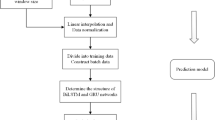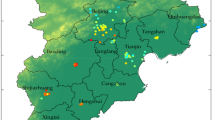Abstract
Air quality forecast is an important technical means to ensure timely and proper response to heavy pollution weather. In this study, a hybrid deep air quality predictor (HDAQP) model consisting of one-dimensional convolutional neural network (CNN), long short-term memory (LSTM), and deep neural network (DNN) is proposed to forecast air quality indicators (mainly PM2.5 concentrations). The proposed model can overcome the limitations of the single model and meanwhile make the best of each. CNN model is used to convolve the historical PM2.5 concentration data along with meteorological data to extract shallow features, while LSTM model is used to extract the deep temporal features. Finally, the DNN model is adopted to transfer these deep features into the final forecast results. Compared with the mainstream deep learning models (e.g., RNN, LSTM, and CNN-LSTM models), the HDAQP model exhibits a better performance in short-term PM2.5 concentration forecast. With the increase of prediction time, the long-term prediction performance of the HDAQP model will be degraded, but it is still better than the mainstream deep learning models. Moreover, considering other meteorological factors, with the multi-source data, the HDAQP model can forecast PM2.5 concentrations more accurately.












Similar content being viewed by others
Notes
In the raw input data, hourly PM2.5 concentrations, air pressure, wind speed, and wind direction are all mean values.
In this paper, short-term (next hour) and long-term (6 h ahead) predictions are mainly implemented. However, long-time-scale (e.g., next day and even next week) PM2.5 concentration forecast is also an important issue, and it is considered as a good direction for our future work.
The HDAQP model can hardly predict pollution peaks in long-term prediction. This situation may stem from the overfitting problem.
References
Bai J (1994) Weak convergence of the sequential empirical processes of residuals in ARMA models. Ann Stat 22(4):2051–2061. https://doi.org/10.2307/2242498
Chakma A, Vizena B, Cao T, Lin J, Zhang J (September 2017) Image-based air quality analysis using deep convolutional neural network. In: 2017 IEEE International Conference on Image Processing (ICIP), IEEE
Falasca S, Curci G (August 2018) High-resolution air quality modeling: sensitivity tests to horizontal resolution and urban canopy with WRF-CHIMERE. Atmos Environ 187:241–254. https://doi.org/10.1016/j.atmosenv.2018.05.048
Guo Y, Tang Q, Gong D-Y, Zhang Z (September 2017) Estimating ground-level PM2.5 concentrations in Beijing using a satellite-based geographically and temporally weighted regression model. Remote Sens of Environ 198:140–149. https://doi.org/10.1016/j.rse.2017.06.001
Ham Y-G, Kim J-H, Luo J-J (September 2019) Deep learning for multi-year ENSO forecasts. Nature 573 (7775):568–572. https://doi.org/10.1038/s41586-019-1559-7
Huang C-J, Kuo P-H (July 2018) A deep CNN-LSTM model for particulate matter (PM2.5) forecasting in smart cities. Sensors 18(7):2220. https://doi.org/10.3390/s18072220
Kampa M, Castanas E (January 2008) Human health effects of air pollution. Environ Pollut 151(2):362–367. https://doi.org/10.1016/j.envpol.2007.06.012
Kim K, Kim D-K, Noh J, Kim M (2018) Stable forecasting of environmental time series via long short term memory recurrent neural network. IEEE Access 6:75216–75228. https://doi.org/10.1109/access.2018.2884827
Krishan M, Jha S, Das J, Singh A, Goyal MK, Sekar C (April 2019) Air quality modelling using long short-term memory (LSTM) over NCT-Delhi, India. Air Qual Atmos Health 12(8):899–908. https://doi.org/10.1007/s11869-019-00696-7
LeCun Y, Bengio Y, Hinton G (May 2015) Deep learning. Nature 521(7553):436–444. https://doi.org/10.1038/nature14539
Liu B, Yan S, Li J, Li Y (December 2016) Forecasting PM2.5 concentration using spatio-temporal extreme learning machine. In: 2016 15th IEEE International Conference on Machine Learning and Applications (ICMLA), IEEE
Liu B, Yan S, Li J, Qu G, Li Y, Lang J, Gu R (2019) A sequence-to-sequence air quality predictor based on the n-step recurrent prediction. IEEE Access 7:43331–43345. https://doi.org/10.1109/access.2019.2908081
Liu W, Xu Z, Yang T (July 2018) Health effects of air pollution in China. Int J Environ Res Public Health 15(7):1471. https://doi.org/10.3390/ijerph15071471
Liu Z, Xie M, Tian K, Gao P (September 2017) GIS-based analysis of population exposure to PM 2.5 air pollution—a case study of Beijing. J Environ Sci 59:48–53. https://doi.org/10.1016/j.jes.2017.02.013
Ong BT, Sugiura K, Zettsu K (June 2015) Dynamically pre-trained deep recurrent neural networks using environmental monitoring data for predicting PM2.5. Neural Comput Appl 27(6):1553–1566. https://doi.org/10.1007/s00521-015-1955-3
Pak U, Kim C, Ryu U, Sok K, Pak S (August 2018) A hybrid model based on convolutional neural networks and long short-term memory for ozone concentration prediction. Air Qual Atmos Health 11 (8):883–895. https://doi.org/10.1007/s11869-018-0585-1
Pires JCM, Sousa SIV, Pereira MC, Alvim-Ferraz MCM, Martins FG (February 2008) Management of air quality monitoring using principal component and cluster analysis—part I: SO2 and PM10. Atmos Environ 42(6):1249–1260. https://doi.org/10.1016/j.atmosenv.2007.10.044
Pires JCM, Sousa SIV, Pereira MC, Alvim-Ferraz MCM, Martins FG (February 2008) Management of air quality monitoring using principal component and cluster analysis—part II: CO, NO2 and o3. Atmos Environ 42(6):1261–1274. https://doi.org/10.1016/j.atmosenv.2007.10.041
Qi Y, Li Q, Karimian H, Liu D (May 2019) A hybrid model for spatiotemporal forecasting of PM2.5 based on graph convolutional neural network and long short-term memory. Sci Total Environ 664:1–10. https://doi.org/10.1016/j.scitotenv.2019.01.333
Qin D, Yu J, Zou G, Yong R, Zhao Q, Zhang B (2019) A novel combined prediction scheme based on CNN and LSTM for urban PM2.5 concentration. IEEE Access 7:20050–20059. https://doi.org/10.1109/access.2019.2897028
Reichstein M, Camps-Valls G, Stevens B, Jung M, Denzler J, Carvalhais N, Prabhat (February 2019) Deep learning and process understanding for data-driven earth system science. Nature 566 (7743):195–204. https://doi.org/10.1038/s41586-019-0912-1
Rybarczyk Y, Zalakeviciute R (December 2018) Machine learning approaches for outdoor air quality modelling: a systematic review. Appl Sci 8(12):2570. https://doi.org/10.3390/app8122570
Sánchez AS, Nieto PJG, Fernández PR, del Coz Díaz JJ, Iglesias-Rodríguez FJ (September 2011) Application of an SVM-based regression model to the air quality study at local scale in the Avilés urban area (Spain). Math Comput Model 54(5-6):1453–1466. https://doi.org/10.1016/j.mcm.2011.04.017
Shang Z, Deng T, He J, Duan X (February 2019) A novel model for hourly PM2.5 concentration prediction based on CART and EELM. Sci Total Environt 651:3043–3052. https://doi.org/10.1016/j.scitotenv.2018.10.193
Sun W, Li Z (June 2020) Hourly PM2.5 concentration forecasting based on feature extraction and stacking-driven ensemble model for the winter of the beijing-tianjin-hebei area. Atmos Pollut Res 11(6):110–121. https://doi.org/10.1016/j.apr.2020.02.022
Tai APK, Mickley LJ, Jacob DJ (October 2010) Correlations between fine particulate matter (PM2.5) and meteorological variables in the United States: implications for the sensitivity of PM2.5 to climate change. Environ Pollut 44(32):3976–3984. https://doi.org/10.1016/j.atmosenv.2010.06.060
Tang Y, Carmichael GR, Thongboonchoo N, Chai T, Horowitz LW, Pierce RB, Al-Saadi JA, Pfister G, Vukovich JM, Avery MA, Sachse GW, Ryerson TB, Holloway JS, Atlas EL, Flocke FM, Weber RJ, Huey LG, Dibb JE, Streets DG, Brune WH (April 2007) Influence of lateral and top boundary conditions on regional air quality prediction: a multiscale study coupling regional and global chemical transport models. J Geophys Res Atmos 112(D10):409–427. https://doi.org/10.1029/2006jd007515
Wang Q, Gracely EJ, Liu L (April 2020) Evidence linking air pollution and blood pressure mediated by body weight in china. Air Qual Atmos Health 13 (5):585–592. https://doi.org/10.1007/s11869-020-00821-x
Wang Z, Maeda T, Hayashi M (2001) A nested air quality prediction modeling system for urban and regional scales: application for high-ozone episode in Taiwan. Water Air Soil Pollut 130(1/4):391–396. https://doi.org/10.1023/A:1013833217916
Wen C, Liu S, Yao X, Peng L, Li X, Hu Y, Chi T (March 2019) A novel spatiotemporal convolutional long short-term neural network for air pollution prediction. Sci Total Environ 654:1091–1099. https://doi.org/10.1016/j.scitotenv.2018.11.086
Yuan W, Wang K, Bo X, Tang L, Wu J (December 2019) A novel multi-factor & multi-scale method for PM2.5 concentration forecasting. Environ Pollut 255:113187. https://doi.org/10.1016/j.envpol.2019.113187
Zhang L, Lin J, Qiu R, Hu X, Zhang H, Chen Q, Tan H, Lin D, Wang J (December 2018) Trend analysis and forecast of PM2.5 in Fuzhou, China using the ARIMA model. Ecol Ind 95:702–710. https://doi.org/10.1016/j.ecolind.2018.08.032
Acknowledgments
We thank the editor and reviewers for their insightful and constructive comments to improve the manuscript significantly.
Funding
This work was supported in part by the Basic Scientific Research of Nantong Science and Technology Project (JC2018081), the Postgraduate Research and Practice Innovation Program of Jiangsu Province (KYCX192058), and the Natural Science Foundation of the Jiangsu Higher Education Institutions of China (19KJB510054).
Author information
Authors and Affiliations
Corresponding author
Additional information
Publisher’s note
Springer Nature remains neutral with regard to jurisdictional claims in published maps and institutional affiliations.
Rights and permissions
About this article
Cite this article
Sun, Q., Zhu, Y., Chen, X. et al. A hybrid deep learning model with multi-source data for PM2.5 concentration forecast. Air Qual Atmos Health 14, 503–513 (2021). https://doi.org/10.1007/s11869-020-00954-z
Received:
Accepted:
Published:
Issue Date:
DOI: https://doi.org/10.1007/s11869-020-00954-z




